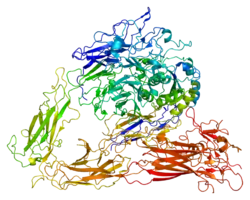Integrin β-3
Integrin β-3 (synonym CD61) ist ein Oberflächenprotein aus der Gruppe der Integrine.
| Integrin beta-3 | ||
|---|---|---|
 | ||
| nach PDB 1JV2 | ||
| Andere Namen |
Platelet membrane glycoprotein IIIa, GPIIIa | |
| Eigenschaften des menschlichen Proteins | ||
| Masse/Länge Primärstruktur | 788 Aminosäuren, 87.058 Da | |
| Bezeichner | ||
| Externe IDs | ||
| Orthologe (Mensch) | ||
| Entrez | 1493 | |
| Ensembl | ENSG00000163599 | |
| UniProt | P05106 | |
| Refseq (mRNA) | NM_001037631.2 | |
| Refseq (Protein) | NP_001032720.1 | |
| PubMed-Suche | 1493 | |
Eigenschaften
CD61 ist ein Zelladhäsionsmolekül und besitzt mehrere Isoformen, von denen A und C in vielen Geweben gebildet werden, z. B. A in Osteoblasten und C in Prostata und Hoden. CD61 bildet mit Integrin α-V einen heterodimeren Rezeptor für Cytotactin, Fibronectin, Laminin, Matrix-Metalloproteinase-2, Osteopontin, Osteomodulin, Prothrombin, Thrombospondin, Vitronectin, Von-Willebrand-Faktor, NRG1, FGF1, IGF1, Fibrillin-1 und Fraktalkin (synonym CX3CL1). Ebenso bildet es einen heterodimeren Rezeptor mit Integrin alpha-IIb für Fibronectin, Fibrinogen, Plasminogen, Prothrombin, Thrombospondin und Vitronectin. Dabei wird die RGD-Sequenz bzw. H-H-L-G-G-G-A-K-Q-A-G-D-V (in der gamma-Kette des Fibrinogens) gebunden. Durch die Bindung des Fibrinogens wird die Blutgerinnung eingeleitet. Weiterhin ist es an der Angiogenese beteiligt, weshalb es zur Behandlung von Tumoren untersucht wird.[1] PLA2G2A bindet an eine andere Bindungsstelle und moduliert die Affinität zum Liganden der Rezeptorfunktion. CD61 ist glykosyliert und phosphoryliert. CD61 bindet zudem PTK2,[2][3] ITGB3BP,[4][5] TLN1[6][7] und CIB1.[8]
Das Heterodimer aus Integrin α-V und β-3 ist der zelluläre Rezeptor für das Zytomegalievirus (HHV-5), HHV-8, das Coxsackievirus A9, das Hantavirus, das humane Metapneumovirus, das humane Parechovirus 1 und das West-Nil-Virus. Bei einer Infektion mit HIV verstärkt die Bindung des Tat-Proteins an das Heterodimer α-V/β-3 die Angiogenese in einem Kaposi-Sarkom.
Weblinks
Einzelnachweise
- F. Danhier, A. Le Breton, V. Préat: RGD-based strategies to target alpha(v) beta(3) integrin in cancer therapy and diagnosis. In: Molecular pharmaceutics. Band 9, Nummer 11, November 2012, S. 2961–2973, doi:10.1021/mp3002733, PMID 22967287.
- B. P. Eliceiri, X. S. Puente, J. D. Hood, D. G. Stupack, D. D. Schlaepfer, X. Z. Huang, D. Sheppard, D. A. Cheresh: Src-mediated coupling of focal adhesion kinase to integrin alpha(v)beta5 in vascular endothelial growth factor signaling. In: Journal of Cell Biology. Band 157, Nummer 1, April 2002, S. 149–160, doi:10.1083/jcb.200109079, PMID 11927607, PMC 2173263 (freier Volltext).
- J. Chung, A. G. Gao, W. A. Frazier: Thrombspondin acts via integrin-associated protein to activate the platelet integrin alphaIIbbeta3. In: The Journal of biological chemistry. Band 272, Nummer 23, Juni 1997, S. 14740–14746, PMID 9169439.
- T. T. Fujimoto, S. Katsutani, T. Shimomura, K. Fujimura: Novel alternatively spliced form of beta(3)-endonexin. In: Thrombosis research. Band 105, Nummer 1, Januar 2002, S. 63–70, PMID 11864709.
- S. J. Shattil, T. O'Toole, M. Eigenthaler, V. Thon, M. Williams, B. M. Babior, M. H. Ginsberg: Beta 3-endonexin, a novel polypeptide that interacts specifically with the cytoplasmic tail of the integrin beta 3 subunit. In: Journal of Cell Biology. Band 131, Nummer 3, November 1995, S. 807–816, PMID 7593198, PMC 2120613 (freier Volltext).
- S. Patil, A. Jedsadayanmata, J. D. Wencel-Drake, W. Wang, I. Knezevic, S. C. Lam: Identification of a talin-binding site in the integrin beta(3) subunit distinct from the NPLY regulatory motif of post-ligand binding functions. The talin n-terminal head domain interacts with the membrane-proximal region of the beta(3) cytoplasmic tail. In: The Journal of biological chemistry. Band 274, Nummer 40, Oktober 1999, S. 28575–28583, PMID 10497223.
- D. A. Calderwood, B. Yan, J. M. de Pereda, B. G. Alvarez, Y. Fujioka, R. C. Liddington, M. H. Ginsberg: The phosphotyrosine binding-like domain of talin activates integrins. In: The Journal of biological chemistry. Band 277, Nummer 24, Juni 2002, S. 21749–21758, doi:10.1074/jbc.M111996200, PMID 11932255.
- U. P. Naik, P. M. Patel, L. V. Parise: Identification of a novel calcium-binding protein that interacts with the integrin alphaIIb cytoplasmic domain. In: The Journal of biological chemistry. Band 272, Nummer 8, Februar 1997, S. 4651–4654, PMID 9030514.